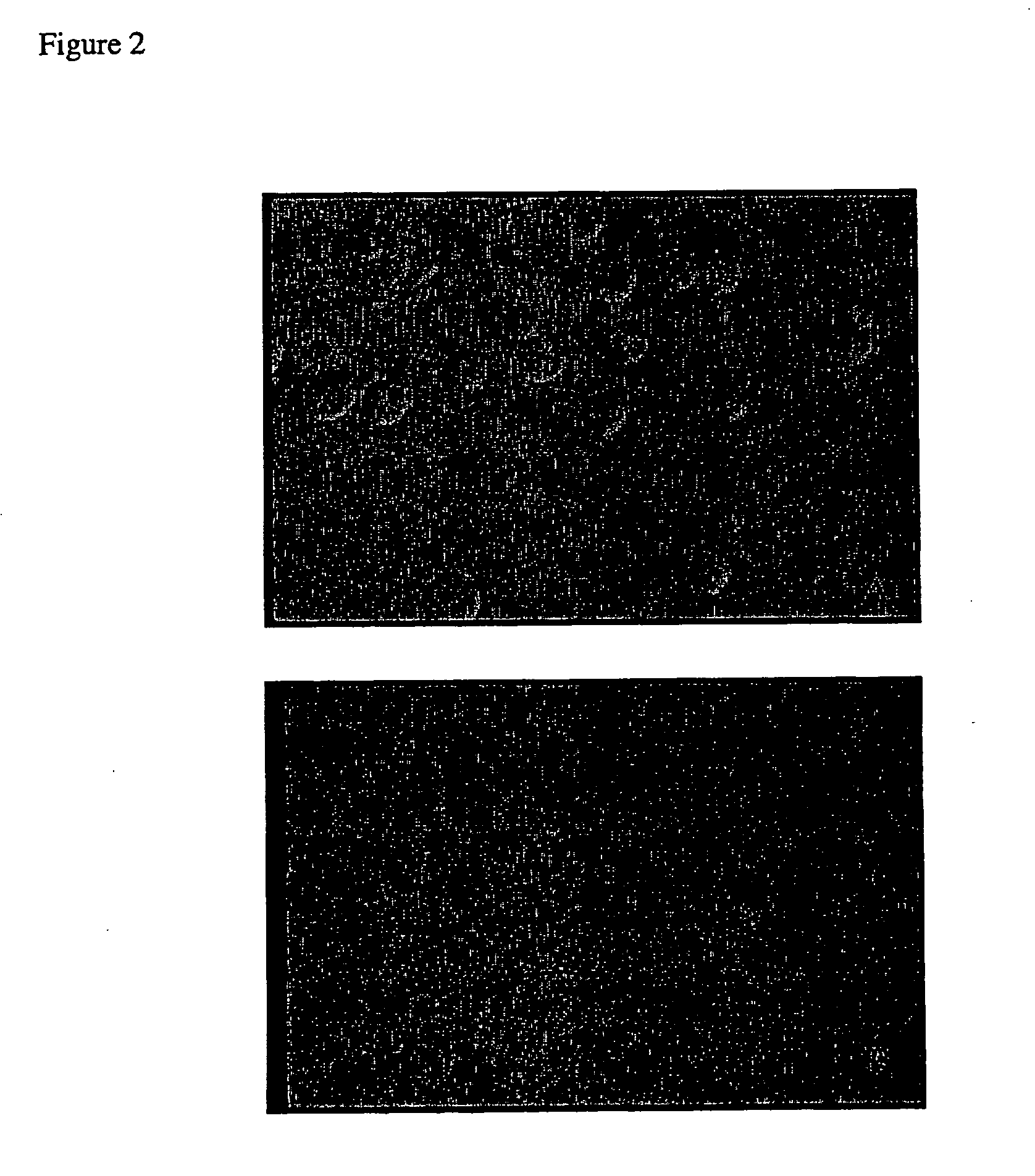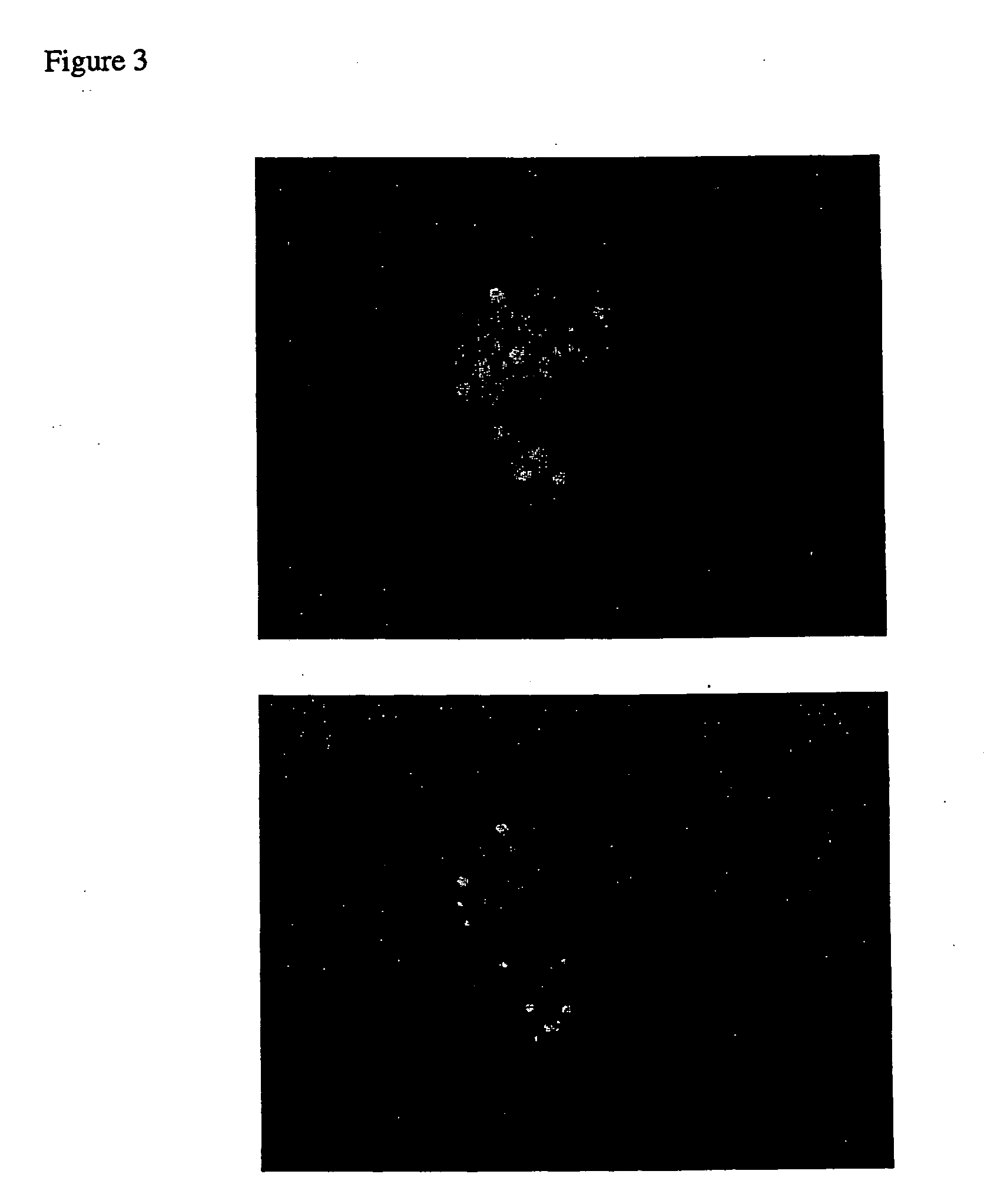Pluripotent mammalian cells
a technology of pluripotent cells and stem cells, applied in the field of stem cells and pluripotent cells, can solve the problems of not being able to repair damaged or diseased tissues with drugs, the replacement of damaged organs and tissues is a major problem, and most organs and tissues regenerate poorly, so as to promote gene activation, enhance chromatin remodelling, and promote stably integrated
- Summary
- Abstract
- Description
- Claims
- Application Information
AI Technical Summary
Benefits of technology
Problems solved by technology
Method used
Image
Examples
example 1
Production of Porcine-porcine Hybrids with Porcine Cytoplasts
[0091] Porcine oocytes arrested at metaphase II of the meiotic cycle were aspirated from pre-ovulatory antral follicles obtained from the ovaries of donor gilts superovulated using standard procedures. The zona pellucidae were removed by incubating oocytes in 0.5 mg / ml Pronase (Sigma Chemical Co., St. Louis, Mo.) in Phosphate Buffered Saline (Gibco BRL, Gaithersburg, Md.) for 10 minutes. Oocytes (200 count) were then incubated in 7.5 μg / ml cytochalasin B (Sigma) in NCSU23 medium (Petters and Wells, J. Rreprod Fert. Suppl. 48:61-73 (1993)) modified to be used as a benchtop holding medium for 5 minutes. The NCSU23 medium was modified by deleting all NaHCO3, adjusting KH2PO4 to 0.44 MM, adding 1.34 mM Na2HPO4, and compensating for the changes in K and Na by adjusting the NaCl and KCl concentrations accordingly. Optimal cytoplast size (30-40 μm) was obtained by vortexing (Vortex Genie 2, Scientific Industries, Bohemia, N.Y.) ...
example 2
Production of Porcine-Rabbit Hybrids with Rabbit Cytoplasts
[0092] Rabbit oocytes arrested at metaphase II of the meiotic cycle were flushed from the oviducts of superovulated 6 month old New Zealand White rabbits, using standard protocols. Both pronase and acid Tyrode's solution failed to remove the zona pellucida. Therefore, the cytoplasts were made manually by micromanipulation using 7.5 μg / ml cytochalasin B (Sigma Chemical Co.) in NCSU23-phosphate medium. The hybrids were produced as described above for the porcine-porcine hybrids. A total of 46 cytoplasts were prepared from 3 oocytes and 21 of them fused with a single fetal fibroblast. In 20 of the fused cytoplasts, there was a single swollen nuclear structure suggesting that the cytoplasts had activated. Proliferative potential could not be measured in these initial trials since the culture medium did not contain any growth factors or serum. The purpose of this experiment was only to evaluate cytoplast preparation and fusion. ...
example 3
Production of Hybrids from Porcine Fetal Fibroblasts with Bovine Cytoplasts: Formation of Stem Cell-like Colonies
[0093] Culture tubes containing bovine cumulus oocyte complexes (COCs) in 5% CO2-equilibrated maturation medium were shipped overnight in a portable isothermal incubator at 39° C. from the oocyte production laboratory (Genetic Technologies International, Brian, Tex.) to our laboratory. At 18 hours of in vitro maturation, COCs were removed from maturation medium and incubated for 10 minutes in modified phosphate buffered synthetic oviductal fluid (SOF-P) supplemented with 0.3 mg / ml hyaluronidase (Sigma). SOF-P medium was formulated as a benchtop medium for bovine oocytes and embryos to be used outside the incubator. The formulation for SOF (Tervit et al., J. Reprod. Fert. 30:493-497 (1972)) was modified by deleting all sodium bicarbonate, changing the BSA concentration to 1 mg / ml, adjusting KH2PO4 to 0.44 mM, adding 1.34 mM Na2HPO4, and compensating for the changes in K a...
PUM
| Property | Measurement | Unit |
|---|---|---|
| pH | aaaaa | aaaaa |
| diameter | aaaaa | aaaaa |
| diameter | aaaaa | aaaaa |
Abstract
Description
Claims
Application Information
 Login to View More
Login to View More - R&D
- Intellectual Property
- Life Sciences
- Materials
- Tech Scout
- Unparalleled Data Quality
- Higher Quality Content
- 60% Fewer Hallucinations
Browse by: Latest US Patents, China's latest patents, Technical Efficacy Thesaurus, Application Domain, Technology Topic, Popular Technical Reports.
© 2025 PatSnap. All rights reserved.Legal|Privacy policy|Modern Slavery Act Transparency Statement|Sitemap|About US| Contact US: help@patsnap.com



